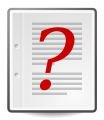Making Predictions: A Mini-Lesson For the High School Classroom
After the semester exam, Billy Neverhere came by to check on his grade. The following exchange took place:
Billy: What did I get on the test?
Me: What do you think you got on the test?
Billy: I don’t know.
Me: Make a prediction. You missed 23 days of school. You left one-third of the questions blank. Your four-paragraph essay is one paragraph.
Billy: An ‘A’?
I ordered Billy out of the room and decided I needed a lesson on making predictions so this would never happen again. I now share it with you.
Mini-Lesson For Any Reading Assignment

Although students are fully capable of making their own chart, they do better if you give them one. This prediction making chart can be used as a pre-reading activity, a during-reading activity or even a post-reading activity.
Method #1 - As a Pre-Reading Activity: The purpose of this activity is to help students focus on potential themes. Most of their predictions will be inaccurate. The focus should be on the reasons behind their predictions, regardless of prediction accuracy.
- Hand students a copy of a novel or short story they are about to read. Instruct them to look at the front and back cover, chapter titles and any pictures accompanying the narrative.
- If necessary, preview the reading selection with pictures or symbols, but don’t tell what the pictures or symbols mean.
- Instruct students to fill out the prediction making chart.
- Collect the charts and put them in a sealed envelope (optional and fun).
- After reading the selection, review student predictions and hand out awards for the best predictions.
- Return the charts and instruct students to complete the “outcome” column.
Method #2 - As a During-Reading Activity: The focus for this activity will be on students’ ability to use evidence and draw logical conclusions based on that evidence. Students who are able to find, use and explain evidence intelligently will have demonstrated mastery of the skill, even if their predictions aren’t 100% accurate (not even the weatherman gets it right all the time).
- Read a short story, novel or play. Stop at a logical point.
- Hand out the making predictions graphic organizer. Instruct students to fill out the chart. Be sure to specify what section of the literary work students are predicting.
- Discuss. Force students to justify their predictions. Make them use evidence and logic. Feel free to assign a paragraph or short essay forcing them to use evidence to support a prediction.
- List 3-5 predictions on the board and have the class vote on which ones are most likely to come true.
- Finish the short story, novel or play. When a prediction is verified, celebrate.
Method #3 - As a Post Reading Activity: Students often want to know what happens to characters after the literary work is finished. Have them make predictions. For example, what happens to George after Lennie dies in Of Mice and Men, by John Steinbeck? How is the town of Verona changed after the deaths of Romeo and Juliet, by William Shakespeare? How does Sanger Rainsford get off Zaroff’s island in “The Most Dangerous Game” by Richard Connell? What exactly happens to Ulrich and Georg in “The Interlopers” by Saki?
Making predictions should be fun. If done correctly, students will be anxiously engaged and enjoying literature.
Images: Public domain image courtesy of Wikimedia Commons.
This post is part of the series: Mini-lessons to Improve Reading Skills
Emphasize skills with these reading skills mini-lessons.
